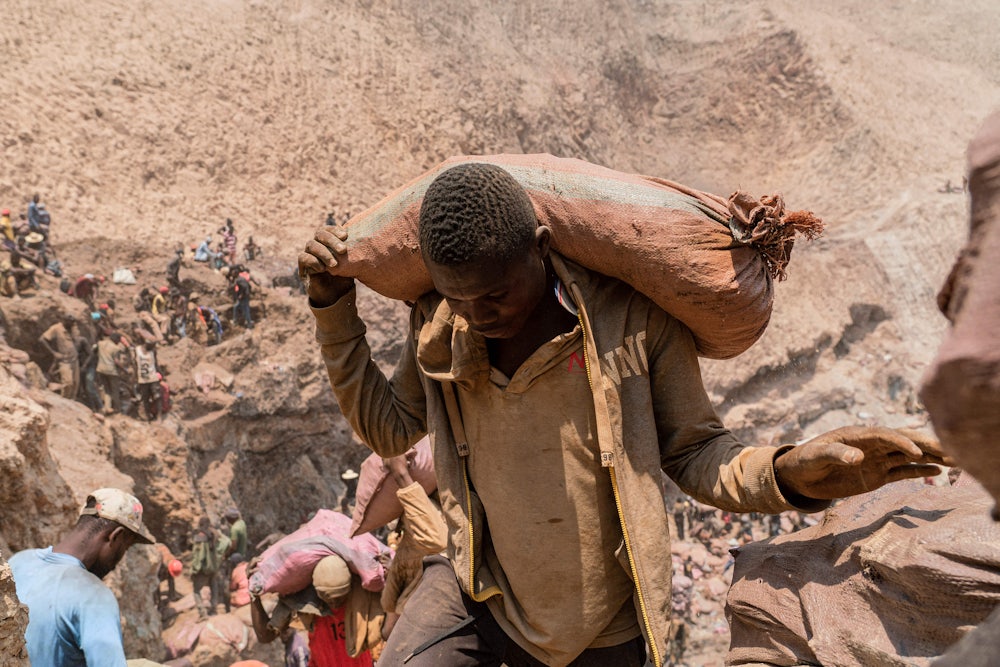Serge Langunu is a graduate student in botany at the University of Lubumbashi in the Democratic Republic of the Congo. In May, he and I were sitting on a bench in the parking lot of a hospital just outside Lubumbashi’s downtown, looking at photos of plants on his laptop.
I met Langunu at the hospital to see an experimental plot of metal-loving plants cultivated by the university’s agronomy department. This understated garden was growing in the shadow of a massive chimney, looming across the street in the mostly abandoned grounds of the old copper smelter named after the state mining corporation, Gécamines.
Lubumbashi is Congo’s second-largest city and the capital of Katanga province, founded in 1910 by the Belgian colonial regime to exploit Katanga’s otherworldly mineral wealth. For about 80 years, the smoke from the smelting of ore from the Étoile du Congo copper mine drifted out of that chimney over the homes of mine workers and their families on the west side of the Lubumbashi River, while mine administrators and other colonial officers enjoyed the cleaner air on the other side. As a result, the soil at the hospital and throughout the surrounding neighborhood is heavily contaminated with copper, cobalt, lead, zinc, and arsenic. The university’s experimental garden uses species from Katanga’s endemic flora, much of which has evolved to be resistant to, or even dependent on, concentrations of metals that would stunt or kill most other plants, to decontaminate the poisoned soil.
“This one is Crotalaria cobalticola,” said Langunu, pointing to an image of an angular, pea-like flower with a vivid yellow hue. “It grows mainly in zones with a high concentration of copper and cobalt.” I leaned in to look closer. Crotalaria is what is known as an obligate metallophyte—it requires the presence of cobalt in order to survive.
Cobalt has become the center of a major upsurge in mining in Congo, and the rapid acceleration of cobalt extraction in the region since 2013 has brought hundreds of thousands of people into intimate contact with a powerful melange of toxic metals. The frantic pace of cobalt extraction in Katanga bears close resemblance to another period of rapid exploitation of Congolese mineral resources: During the last few years of World War II, the U.S. government sourced the majority of the uranium necessary to develop the first atomic weapons from a single Congolese mine, named Shinkolobwe. The largely forgotten story of those miners, and the devastating health and ecological impacts uranium production had on Congo, looms over the country now as cobalt mining accelerates to feed the renewable energy boom—with little to no protections for workers involved in the trade.
The city of Kolwezi, which is 300 km (186 miles) northwest of Lubumbashi and 180 km from the now-abandoned Shinkolobwe mine, sits on top of nearly half of the available cobalt in the world. The scope of the contemporary scramble for that metal in Katanga has totally transformed the region. Enormous open-pit mines worked by tens of thousands of miners form vast craters in the landscape and are slowly erasing the city itself.
The global shift toward renewable energy has hugely increased the world’s demand for metals for batteries, creating a new opportunity for Congo, the world’s largest producer of cobalt. Companies like Tesla, Apple, Samsung, and Chrysler source significant percentages of their cobalt from the country.
Much of the cobalt in Congo is mined by hand: Workers scour the surface level seams with picks, shovels, and lengths of rebar, sometimes tunneling by hand 60 feet or more into the earth in pursuit of a vein of ore. This is referred to as artisanal mining, as opposed to the industrial mining carried out by large firms. The thousands of artisanal miners who work at the edges of the formal mines run by big industrial concerns make up 90 percent of the nation’s mining workforce and produce 30 percent of its metals. Artisanal mining is not as efficient as larger-scale industrial mining, but since the miners produce good-quality ore with zero investment in tools, infrastructure, or safety, the ore they sell to buyers is as cheap as it gets. Forced and child labor in the supply chain is not uncommon here, thanks in part to a significant lack of controls and regulations on artisanal mining from the government.
Congo’s mineral resources are found in two broad geographical curves, arcs of mineral-rich surface-level rock that converge on the city of Lubumbashi. This region, known as the Copperbelt, has been mined for more than a century for minerals like copper, cobalt, nickel, gold, and uranium. Some of those deposits are among the richest of their kind in the world, and the workers in those mines are among the most exploited on the planet. Conditions in the mining regions have changed little in the century since the opening of the Shinkolobwe mine, whose highly concentrated uranium ore supercharged both the U.S. and German military projects to develop atomic weapons during World War II.
For the 15 years after its use in the bombs dropped over Hiroshima and Nagasaki, most of the uranium mined for the Manhattan Project’s subsequent bomb-building efforts came out of the Shinkolobwe mine, sited at the edge of the arc of Congo’s richest metal-bearing soils. Shinkolobwe’s intensely powerful ore was essential to the rapid design, development, and detonation of the world’s first atomic weapons, and the construction of the thousands that followed.
Shinkolobwe was opened in 1921 by the Belgian colony’s minerals consortium, Union Minière. Although many of the Katanga region’s mines were focused on veins of copper-bearing malachite, Shinkolobwe was mined for decades for its radium, which was used in cancer treatments and to make watch dials glow in the dark. The masses of bright-yellow uranium ore that came up along with the radium were initially discarded as waste rock: There were scant commercial usages for uranium until the war began.
When later atomic research found that uranium’s unstable nucleus could be used to make a powerful bomb, the U.S. Army’s Manhattan Project began searching for a reliable source of uranium. They found it through Union Minière, which sold the United States the first 1,000 tons it needed to get the bomb effort off the ground.
The Manhattan Project sent agents of the OSS, precursor to the CIA, to Congo from 1943 to 1945 to supervise the reopening of the mine and the extraction of Shinkolobwe’s ore—and to make sure none of it fell into the hands of the Axis powers. Every piece of rock that emerged from the mine for almost two decades was purchased by the Manhattan Project and its successors in the Atomic Energy Commission, until the mine was closed by the Belgian authorities on the eve of Congolese independence in 1960. After that, the colonial mining enterprise Union Minière became the national minerals conglomerate Gécamines, which retained much of the original structure and staff.
Dr. Celestin Banza Lubaba, a professor of toxicology in the School of Public Health at the University of Lubumbashi, researches the health conditions of mine workers in southeast Congo’s minerals sector. What complicates his work, he told me, is that many of the ores in the Copperbelt are amalgams of different metals: the richest cobalt veins occur in heterogeneous masses that combine cobalt with copper, manganese, nickel, and uranium. The intermixing of the ores makes assessing the specific health effects of working with one or another metal very difficult.
Dr. Lubaba showed me the small battery-operated Geiger counters that he uses in the field to measure radioactivity. He had begun the process of trying to find and interview the descendants of the Shinkolobwe miners, but he explained that tracing the health consequences of working in that specific mine would be difficult: Many long-established villages in the area have been demolished and cast apart as cobalt extraction has torn through the landscape. His initial inquiries suggested that at least some of the descendants of the Shinkolobwe miners had been drawn into the maelstrom of digging in the region around Kolwezi.
The miners who extracted some of the most powerful stones ever found with rudimentary tools and their bare hands are hardly mentioned in histories written about the bomb. In her book Being Nuclear: Africans and the Global Uranium Trade, historian Gabrielle Hecht recounts the U.S. Public Health Service’s efforts to investigate the effects of uranium exposure on people who worked closely with the metal and the ore that bore it. In 1956, a team of medical researchers from the PHS paid a visit to Shinkolobwe while the mine was still producing more than half of the uranium used in America’s Cold War missile programs. Most of their questions went unanswered, however, as Shinkolobwe’s operators had few official records to share and stopped responding to communications as soon as the researchers left.
The invisibility of Shinkolobwe mine workers in the historical record arises partly from the culture of secrecy imposed on the mine and its products during the production of the bomb. In Dr. Susan Williams’s book Spies in the Congo, a history of the Manhattan Project in Africa, she describes how the OSS was engaged in a complex and lethal struggle against the Nazi military to deny it access to the Shinkolobwe ore. After the Manhattan Project commandeered the mine in 1943 and forced miners to work round-the-clock shifts in the open pit under searchlights, the mine’s name was formally interdicted from reproduction and erased from maps.
“Don’t ever use that word in anybody’s presence. Not ever!” Williams quotes OSS agent Wilbur Hogue snapping at a subordinate who had said the mine’s name in a café in Congo’s capital. “There’s something in that mine that both the United States and Germany want more than anything else in the world. I don’t know what it’s for. We’re not supposed to know.”
“We don’t know what the health consequences are for prolonged exposure to many of these metals,” said Lubaba. “We do know that the fish that people used to get out of the rivers next to these mines are all gone. The water is undrinkable.” One of the few medical papers describing the consequences of lengthy exposure to cobalt dust, based on research in Katanga, was published in The Lancet in 2020; it found a correlation between exposure to high levels of cobalt and arsenic and the high rate of birth defects in the region’s children.
Lubaba showed me photos of artisanal miners in the shadow of massive tailings piles near the town of Manono. Canadian company Tanatalex Lithium Resources is currently processing the tailings for the lithium left behind by previous operations. Manono sits at the southern end of the other major arc of Congolese minerals: the Tin Belt, which stretches north toward Rwanda and yields huge quantities of lithium, tin, and coltan, essential for various forms of high-tech manufacturing. Many artisanal miners find their work digging through the leftovers of industrial interests that have moved on.
I asked if I could visit Shinkolobwe; Lubaba told me the site itself is restricted and off-limits to foreigners. I mentioned that I had noticed a new operation adjacent to Shinkolobwe’s abandoned pit while surveying the area via Google Maps. He said that could be one of the many new Chinese-run operations that have opened across Katanga over the course of the last 15 years. “They say they are mining gold, but many presume that they are also pursuing uranium,” he said. “They are certainly after cobalt, like everyone else.”
Chinese metals firms took over the old Gécamines smelter in Lubumbashi, along with many of Congo’s industrial mining operations, after Western mineral interests like De Beers, Freeport McMoran, and BHP Group cut their losses following the financial collapse of 2008. Over the next decade, deals between Chinese metals consortiums and former President Joseph Kabila saw some tens of millions generated from the sale of state-owned capital funneled directly to the president’s family. Corruption probes into these deals resulted in further consolidation, with firms like China Molybdenum closing deals worth $3 billion to extract Katanga’s cobalt.
At the abandoned Shinkolobwe mine, the activities of artisanal miners are visible on Google satellite images; concavities and tunnel mouths where miners have been digging for cobalt in recent years stipple the satellite images of the 60-year old refuse heaps surrounding the collapsed mine shaft at the center of the site. The national army closed the mine and burned the nearby villages after a lethal tunnel collapse in 2004. The government limits access to the area now, Lubaba said, but they are allowing people to dig the site in secret, usually at night.
Professor Donatien Dibwe Dia Mwembu of the History Department at Lubumbashi University wrote his dissertation in the 1960s on the history of mine worker health in the Katanga region. “During my research into the morbidity and mortality of miners in Katanga, I found myself reading about silicosis in the Gécamines archives and was chided by the director not to publish what I read,” he told me. “Some months later that entire archive was disappeared by the authorities—and this was simply information about silicosis, the most common mine worker ailment. The effects that uranium had on the miners were much worse.” The delayed onset of the effects of prolonged exposure to the dust of cobalt and uranium has made it difficult to accurately describe the health problems that people face, he said, and mining interests have always been eager to avoid responsibility for worker illness.
It’s not just Congolese miners who felt health impacts from the making of the bomb. In the U.S., Shinkolobwe’s uranium has left a deadly impact on towns across the country where it was processed, as residents still grapple with the cancers, blood diseases, and soil pollution that the contamination caused.
There is a common story about Shinkolobwe miners, which I heard from Dibwe and from several other sources across Lubumbashi, including artists at the Picha Art Center, scientists at the office of the Atomic Energy Commission, and taxi drivers. The story goes that men who had worked in the Shinkolobwe mine would return to their villages on the weekends for rest, and that when those men entered the village bar for a beer, the signal on the television would distort and the screen would fill with static. “According to the story, this happened in their homes as well,” said Dibwe.
In the hospital parking lot, Langunu scrolled through photos of a team of graduate students in white coveralls and yellow plastic helmets, posing around a battered pickup truck full of native plants in a landscape of bare, scraped dust. Under one of the few environmental rules that regulate Katanga’s minerals sector, newly licensed industrial mining operations are required to invite teams from the university to survey for the endangered plants that rely on metallic soils.
“When we find the endemic plants,” he said, “we either relocate them to a site established for their maintenance or try to collect and preserve their seeds. After the mining concessionaires finish extracting the minerals, we reinstall the plants in the disturbed site.” At least one plant, Crepidorhopalon perennis, is now found only in the university’s gardens, its entire habitat having been destroyed by the Étoile du Congo mine.
I recalled the city-size holes that I’d seen from the air on my approach to Lubumbashi airport. How much was it possible to preserve?
“We save what we can,” said Langunu. “The hill no longer exists, and the plant is functionally extinct, but we hope at some point to restore it.”










